Windows shellcoding - part 2. Find kernel32 address
﷽
Hello, cybersecurity enthusiasts and white hackers!
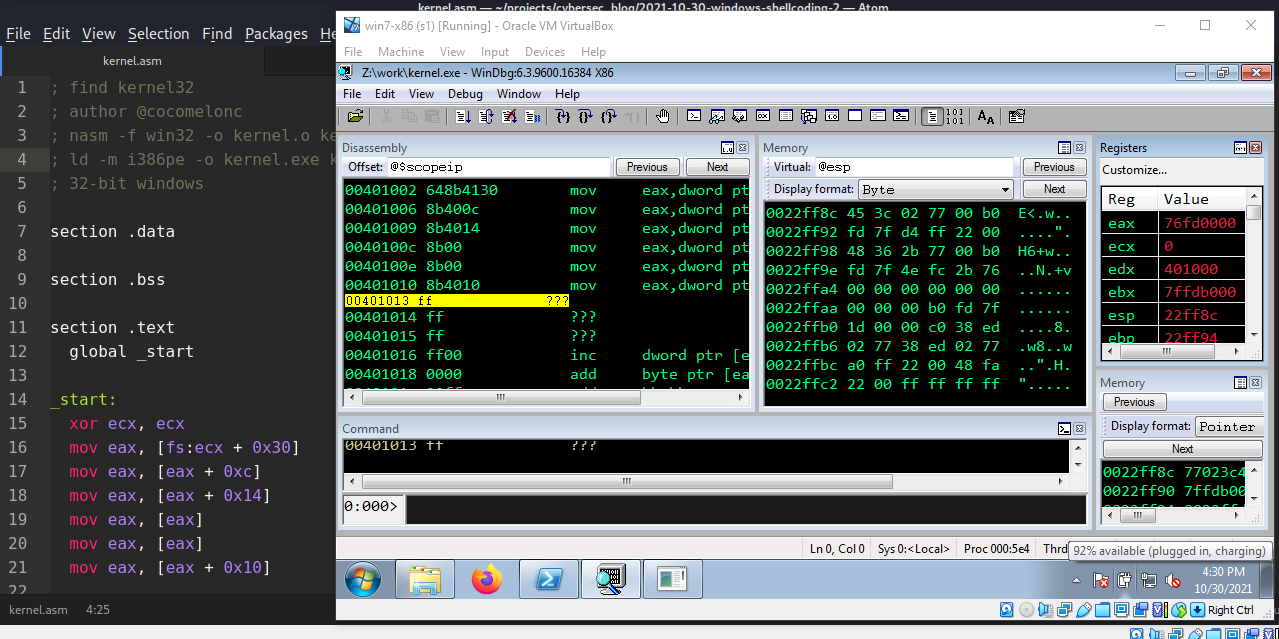
In the first part of my post about windows shellcoding we found the addresses of kernel32 and functions using the following logic:
/*
getaddr.c - get addresses of functions
(ExitProcess, WinExec) in memory
*/
#include <windows.h>
#include <stdio.h>
int main() {
unsigned long Kernel32Addr; // kernel32.dll address
unsigned long ExitProcessAddr; // ExitProcess address
unsigned long WinExecAddr; // WinExec address
Kernel32Addr = GetModuleHandle("kernel32.dll");
printf("KERNEL32 address in memory: 0x%08p\n", Kernel32Addr);
ExitProcessAddr = GetProcAddress(Kernel32Addr, "ExitProcess");
printf("ExitProcess address in memory is: 0x%08p\n", ExitProcessAddr);
WinExecAddr = GetProcAddress(Kernel32Addr, "WinExec");
printf("WinExec address in memory is: 0x%08p\n", WinExecAddr);
getchar();
return 0;
}
Then we entered the found address into our shellcode:
; void ExitProcess([in] UINT uExitCode);
xor eax, eax ; zero out eax
push eax ; push NULL
mov eax, 0x76ed214f ; call ExitProcess function addr in kernel32.dll
jmp eax ; execute the ExitProcess function
The caveat is that the addresses of all DLLs and their functions change upon reboot and differ in each system. For this reason, we cannot hard-code any addresses in our ASM code:
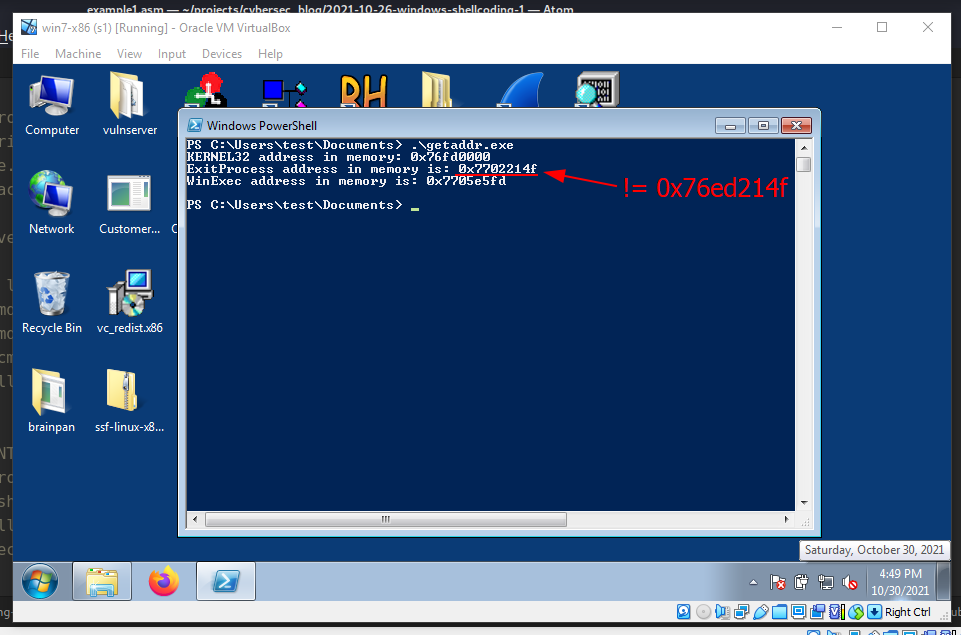
First of all, how do we find the address of kernel32.dll?
TEB and PEB structures
Whenever we execute any exe file, the first thing that is created (at least to my knowledge) in the OS are PEB:
typedef struct _PEB {
BYTE Reserved1[2];
BYTE BeingDebugged;
BYTE Reserved2[1];
PVOID Reserved3[2];
PPEB_LDR_DATA Ldr;
PRTL_USER_PROCESS_PARAMETERS ProcessParameters;
PVOID Reserved4[3];
PVOID AtlThunkSListPtr;
PVOID Reserved5;
ULONG Reserved6;
PVOID Reserved7;
ULONG Reserved8;
ULONG AtlThunkSListPtr32;
PVOID Reserved9[45];
BYTE Reserved10[96];
PPS_POST_PROCESS_INIT_ROUTINE PostProcessInitRoutine;
BYTE Reserved11[128];
PVOID Reserved12[1];
ULONG SessionId;
} PEB, *PPEB;
and TEB:
typedef struct _TEB {
PVOID Reserved1[12];
PPEB ProcessEnvironmentBlock;
PVOID Reserved2[399];
BYTE Reserved3[1952];
PVOID TlsSlots[64];
BYTE Reserved4[8];
PVOID Reserved5[26];
PVOID ReservedForOle;
PVOID Reserved6[4];
PVOID TlsExpansionSlots;
} TEB, *PTEB;
PEB - process structure in windows, filled in by the loader at the stage of process creation, which contains the information necessary for the functioning of the process.
TEB is a structure that is used to store information about threads in the current process, each thread has its own TEB.
Let’s open some program in the windbg debugger and run command:
dt _teb

As we can see, PEB has an offset of 0x030. Similarly, we can see the contents of the PEB structure using command:
dt _peb
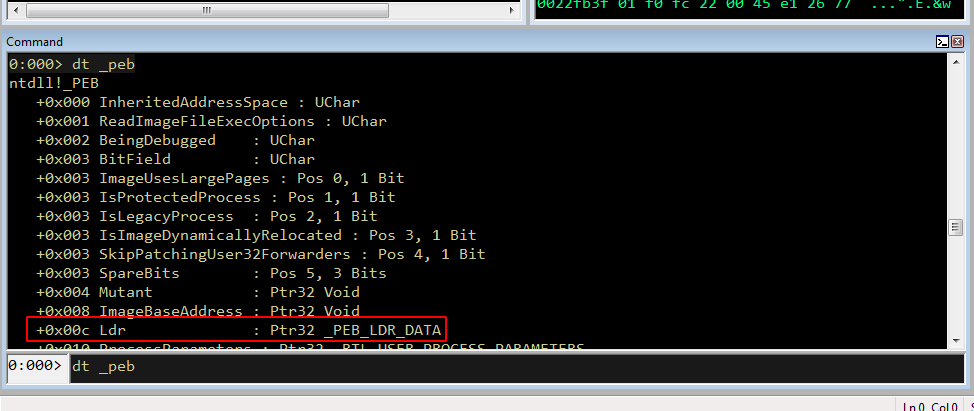
We now need to look at the member that is at an offset of 0x00c from the base of the PEB structure, which is the PEB_LDR_DATA. PEB_LDR_DATA contains information about the loaded modules for the process.
Then, we can also examine PEB_LDR_DATA structure via windbg:
dt _PEB_LDR_DATA
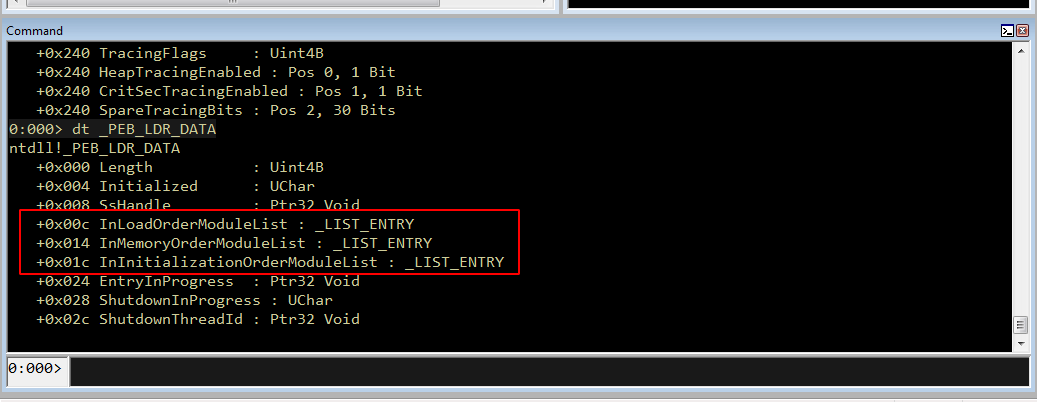
Here we can see that the offset of InLoadOrderModuleList is 0x00c, InMemoryOrderModuleList is 0x014, and InInitializationOrderModuleList is 0x01c.
InMemoryOrderModuleList is a doubly linked list where each list item points to an LDR_DATA_TABLE_ENTRY structure, so Windbg suggests the structure type is LIST_ENTRY.
Before we continue let’s run the command:
!peb
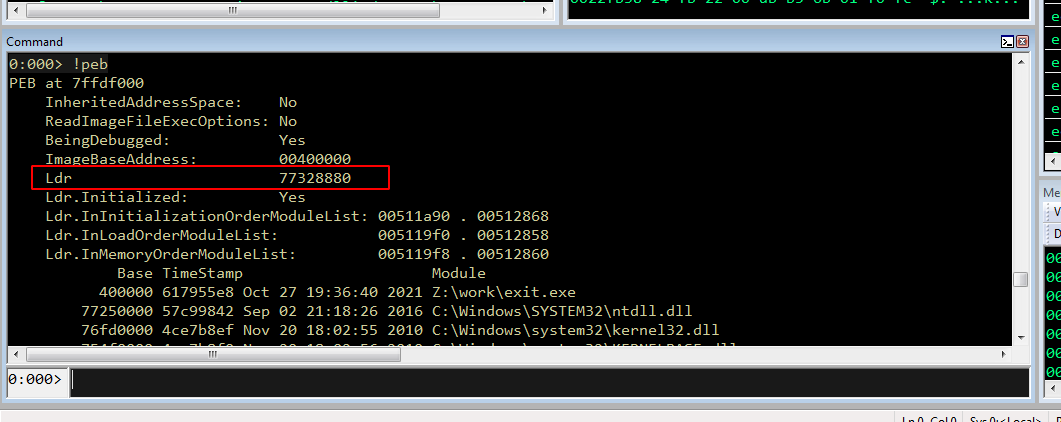
As we can see, LDR (PEB structure) address is - 77328880.
Now to see the addresses of the InLoadOrderModuleList, InMemoryOrderModuleList and InInitializationOrderModuleList run the command:
dt _PEB_LDR_DATA 77328880
This will show us the corresponding start addresses and end addresses of linked lists:
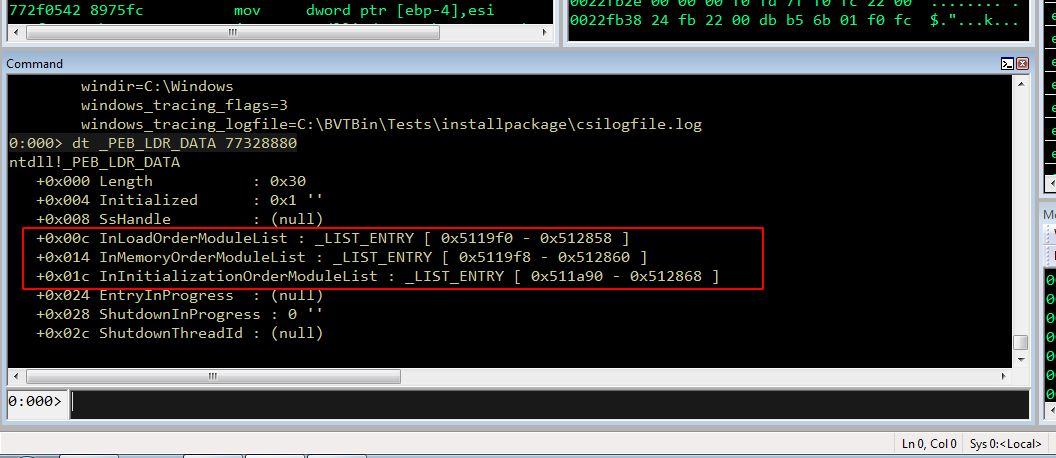
Let’s try to view the modules loaded into the LDR_DATA_TABLE_ENTRY structure, and we will also indicate the starting address of this structure at 0x5119f8 so that we can see the base addresses of the loaded modules. Remember that 0x5119f8 is the address of this structure, so the first entry will be 8 bytes less than this address:
dt _LDR_DATA_TABLE_ENTRY 0x5119f8-8
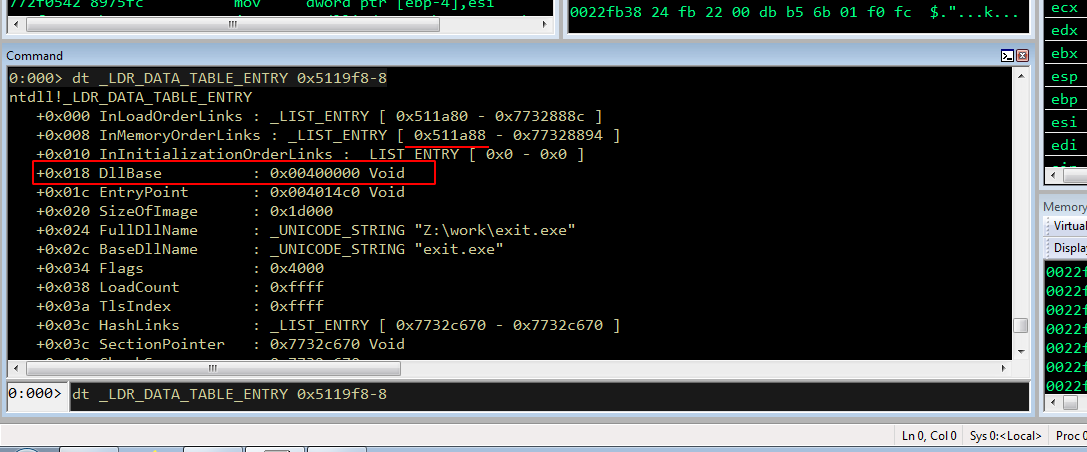
As you can see BaseDllName is our exit.exe. This is exe I executed.
Also, you can see that the InMemoryOrderLinks address is now 0x511a88. DllBase at offset 0x018 contains the base address BaseDllName. Now our next loaded module should be 8 bytes away from 0x511a88, namely 0x5119f8-8:
dt _LDR_DATA_TABLE_ENTRY 0x5119f8-8
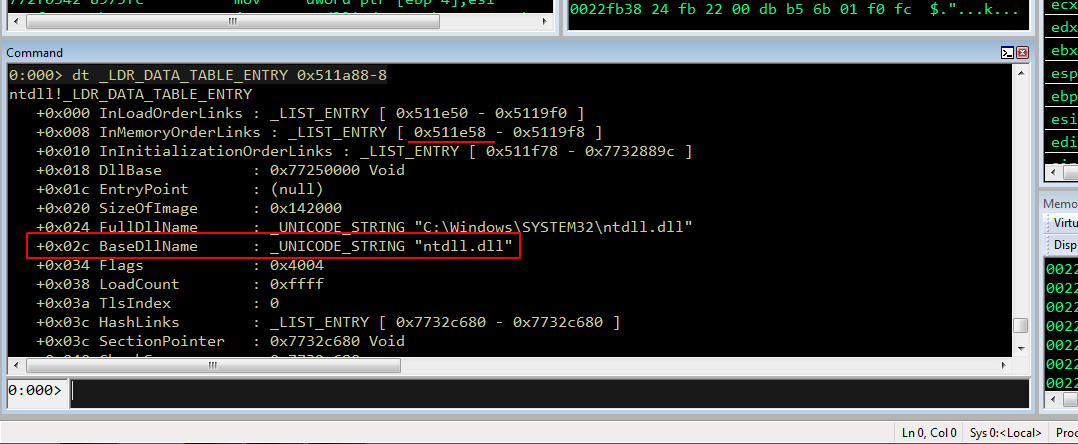
As you can see BaseDllName is ntdll.dll. It’s address is 0x77250000 and the next module is 8 bytes after 0x511e58. So, then:
dt _LDR_DATA_TABLE_ENTRY 0x511e58-8

As you can see our third module is kernel32.dll and it’s address is 0x76fd0000, offset is 0x018. To make sure that it is correct, we can run our getaddr.exe:
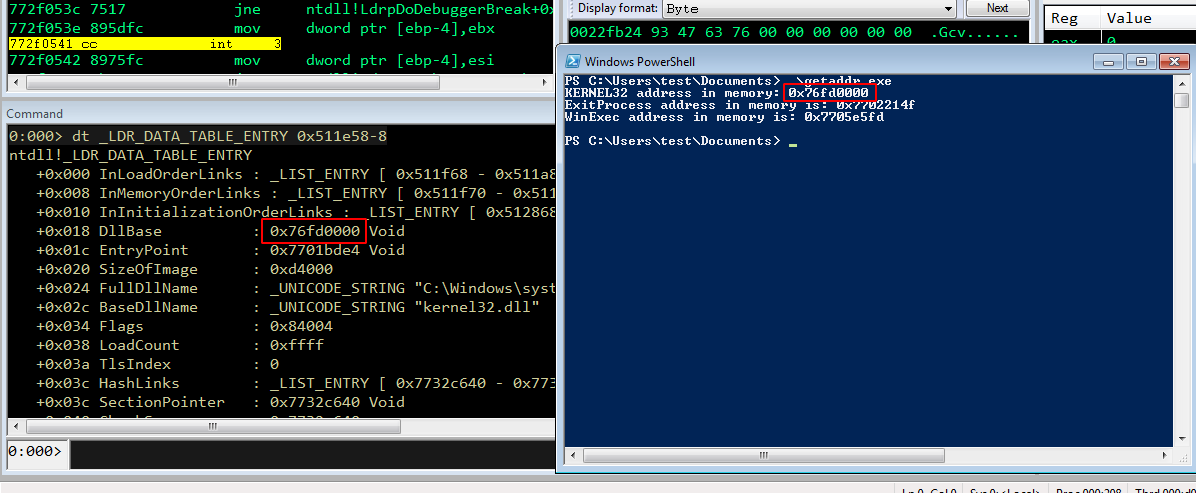
This module loading order will always be fixed (at least to my knowledge) for Windows 10, 7. So when we write in ASM, we can go through the entire PEB LDR structure and find the kernel32.dll address and load it into our shellcode.
As I wrote in the first part, The next module should be kernelbase.dll. Just for experiment, to make sure that it is correct, we can run:
dt _LDR_DATA_TABLE_ENTRY 0x511f70-8
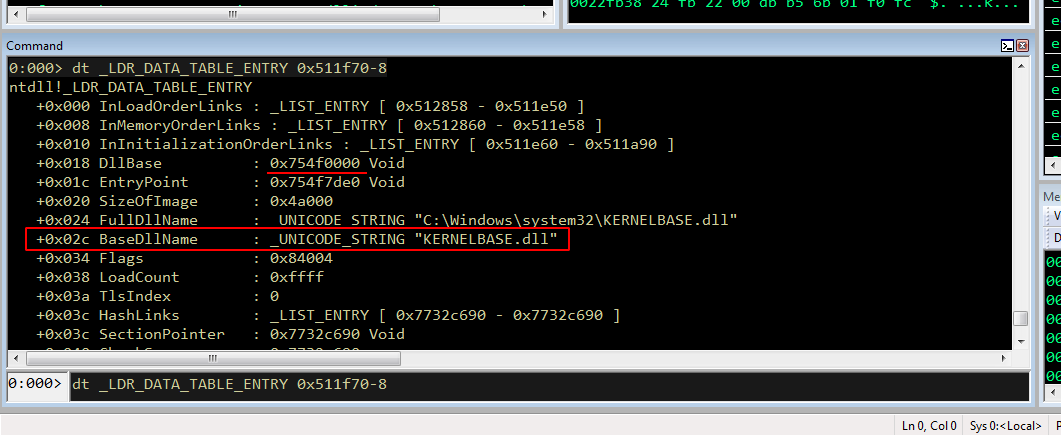
Thus, the following is obtained:
- offset to the
PEBstruct is0x030 - offset to
LDRwithinPEBis0x00c - offset to
InMemoryOrderModuleListis0x014 - 1st loaded module is our
.exe - 2nd loaded module is
ntdll.dll - 3rd loaded module is
kernel32.dll - 4th loaded module is
kernelbase.dll
In all recent versions of the Windows OS (at least to my knowledge), the FS register points to the TEB. Therefore, to get the base address of our kernel32.dll (kernel.asm):
; find kernel32
; author @cocomelonc
; nasm -f win32 -o kernel.o kernel.asm
; ld -m i386pe -o kernel.exe kernel.o
; 32-bit windows
section .data
section .bss
section .text
global _start ; must be declared for linker
_start:
mov eax, [fs:ecx + 0x30] ; offset to the PEB struct
mov eax, [eax + 0xc] ; offset to LDR within PEB
mov eax, [eax + 0x14] ; offset to InMemoryOrderModuleList
mov eax, [eax] ; kernel.exe address loaded in eax (1st module)
mov eax, [eax] ; ntdll.dll address loaded (2nd module)
mov eax, [eax + 0x10] ; kernel32.dll address loaded (3rd module)
With this assembly code we can find the kernel32.dll address and store it in EAX register, so compile it:
nasm -f win32 -o kernel.o kernel.asm
ld -m i386pe -o kernel.exe kernel.o

Copy it and run it in debugger on windows 7:
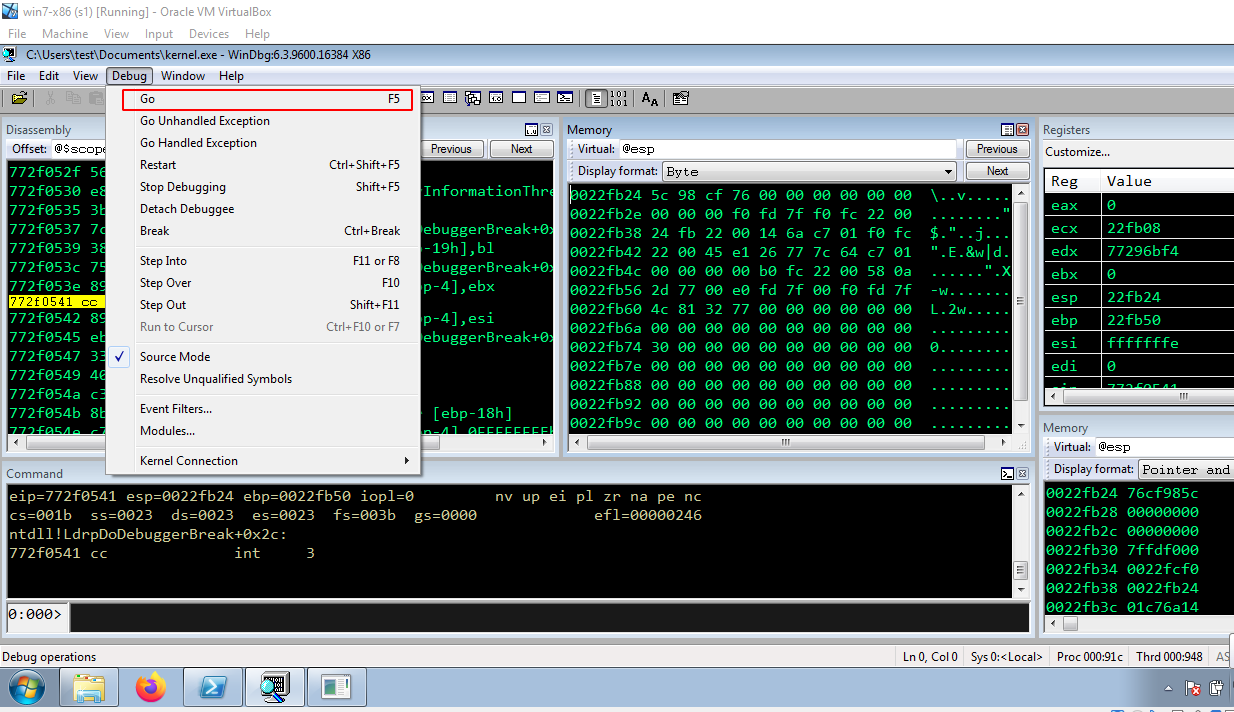
run:
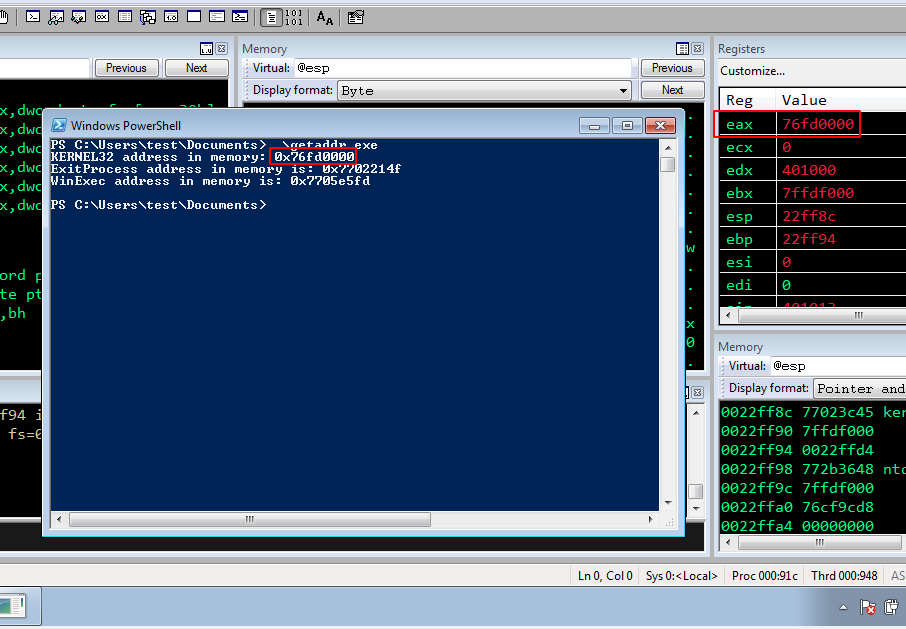
As you can see everything is worked perfectly!
The next step is to find the address of function (for example ExitProcess) using LoadLibraryA and call the function. This will be in the next part.
This is a practical case for educational purposes only.
History and Advances in Windows Shellcode
PEB structure
TEB structure
PEB_LDR_DATA structure
The Shellcoder’s Handbook
windows shellcoding part 1
Source code in Github
Thanks for your time, happy hacking and good bye!
PS. All drawings and screenshots are mine




